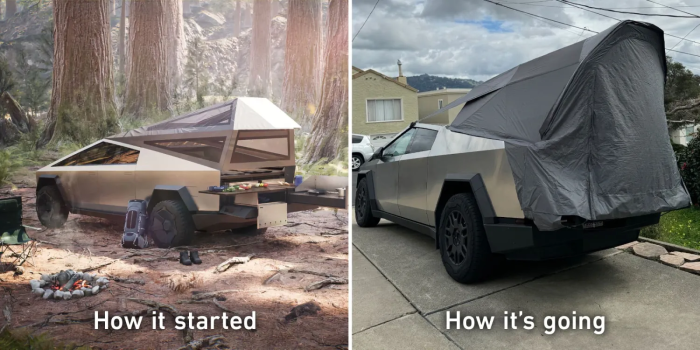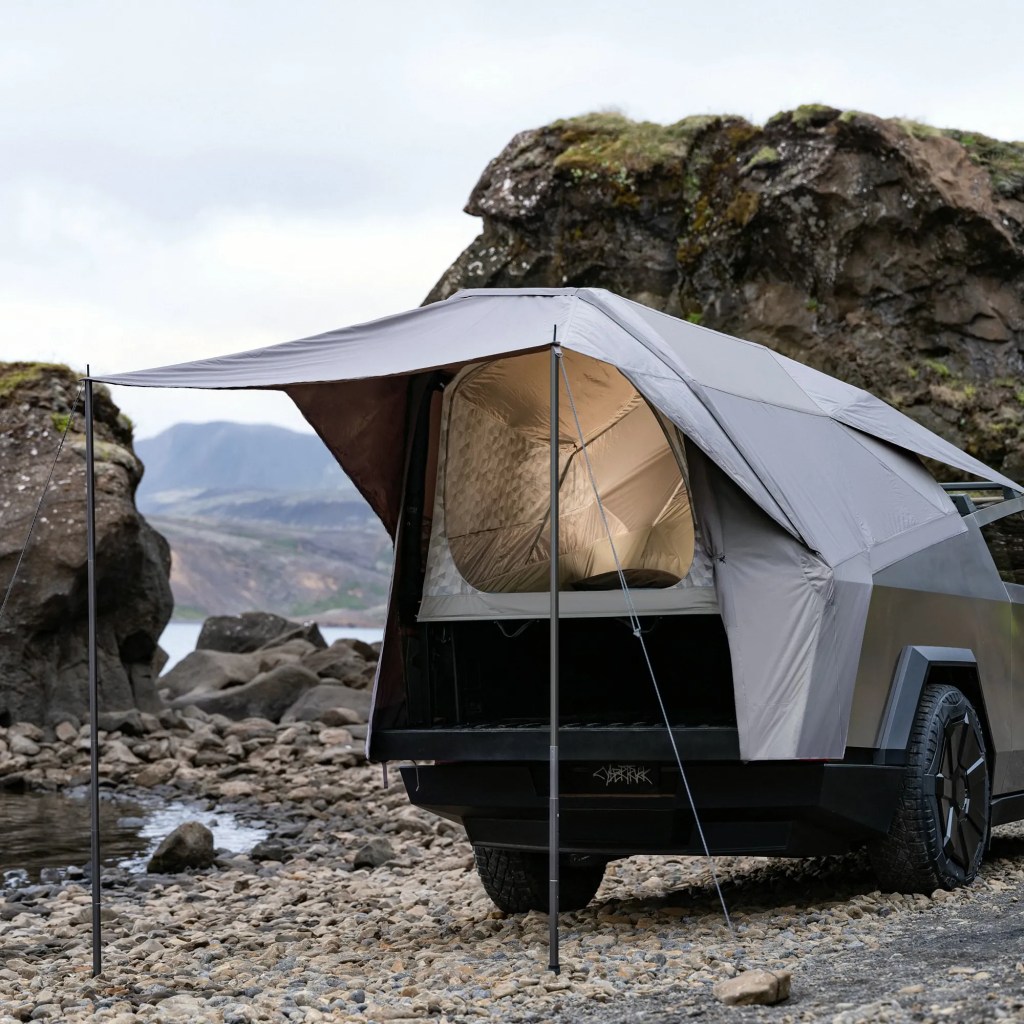Tela’s Basecamp, a project associated with the Cybertruck, is a $3000 tent. It was marketed as a pristine, aesthetic, and on-spot tent to assist campers and adventurers when roaming around in their Tesla Cybertruck. But the initial reveal has been nothing short of disappointing. Still, customers will have to resort to the basecamp, as Tesla’s peculiar design makes using the shelve tents with the Cybertruck a little tricky.
The base camp was announced with the Cybertruck’s original unveiling in 2019. When announced, it looked very appealing, with a sturdy bottom that matched the overall look of the Cybertruck. The tents were released for sale after Tesla revealed the production version of the truck last year, and customers were a little shocked, as it looked less like the base camp and more like a disappointment.
Instead of installing the basecamp, Tesla has started shipping it to top the poor customer care/service. Now, Tesla has begun shipping, or instead installing, the Basecamp for early Cybertruck owners. Why is that a point of concern? You need your first installation at a Tesla Service Center to attach the tent’s brackets, which support the tent’s base, to the Cybertruck’s vault side rails.

TownBiz, one of the first Cybertruck owners to get the Basecamp, said the following about his experience.
“Although Tesla is requiring SCs to do the initial install, in reality, both installation and removal of the tent from the bed (aka “vault”) is straightforward as long as you can deadlift 90lbs and/or have a buddy to help lift. Basecamp has six brackets that attach to the vault’s side rails and have specific spacing. Attaching these brackets is simple: same as how you attach your bottle opener or tie-down points that come with Foundation Series trucks. Assuming Tesla requires the SC to do it because of potential liability issues with/ people not putting the brackets in the right positions. That said, the manual provides installation instructions for anyone to put these brackets in, so I suspect that Tesla may ship them directly to customers one day. The trickiest parts of the initial installation are setting the stowed Basecamp in the right slot (need to put it in at a slight angle closest to the truck’s bed) and aligning the two T25 bolts that secure Basecamp’s frame to the truck. The manual recommends using a flashlight to align the holes, which makes it pretty easy. Unfortunately, the SC installer had some difficulty with this initially. It scratched one of my brackets and may have also slightly messed up the threading on that bracket because it’s a little loose – not a show stopper, and theoretically, it’s a replaceable part. Once you remove those two T25 bolts, you can take the zipped-up Basecamp with the frame out of the truck and store it at home. This is welcome news because it cuts into the length of your bed/vault (a bit more than 1/3 closest to the truck’s cab) if you like to transport adult-sized mountain bikes using a tailgate pad. Otherwise, as mentioned, the design is great because you can store gear under the stowed Basecamp.”
The owner also noted a few issues with the installation, packing, and unpacking process. He is not sure if he can recommend it for $3,000:
“Because the rainy weather hasn’t allowed me to do a full setup + takedown more than once, I still can’t definitively say whether or not I recommend the $3K Basecamp. On the one hand, I think that much of the thoughtful and unique design elements might warrant the cost: it’s fairly lightweight + easy to install/remove the stowed tent from the truck, stays out of the way (unless you want to transport multiple bikes in the bed), doesn’t reduce range due to decreased aerodynamics, and has intuitive pieces that make setup + takedown a breeze. On the other hand, some unpolished areas stick out because of all those great elements I mentioned already: removing + re-installing the “Aeroflap” and the frustration of fitting and zipping up the stowed Basecamp in softcover after you finish using the tent. The three minor damaged pieces (the scuffed + potentially thread-damaged middle bracket where a T25 bolt secures the stowed Basecamp to the bed rail, one of the leg quick-release buttons, and the nylon webbing for one of the cobra buckle retainers) that I mentioned might have been better designed and will need to be fixed too, but because they don’t impede the function of the tent, they’re not show stoppers. The currently MIA “Tent Mode” is also a bit of a red flag because the rumored self-leveling element is a pretty big deal for roof-top-tent camping – briefly laying on the sleeping mat while parked in my gently sloped driveway, I could feel myself rolling downhill. If Tesla releases Tent Mode to all CT owners or only verified Basecamp owners may be a deciding factor for people buying the Basecamp or waiting for a 3rd party solution (theoretically, if a maker creates cross bars for the vault, other folding rooftop tents that are not wider than the vault/bed could work nicely). $3K is a serious change, and you could buy a lot of sweet camping gear with it. However, as I mentioned initially, $3K for a high-quality rooftop tent is not crazy.”
Cybertrucks lacks the software to enable the truck’s air suspension to auto-level. Unfortunately, there is no way to link the truck’s AC to the tent with this system either. So, in a nutshell, the base’s initial delivery has been a big letdown for all Tesla lovers.



